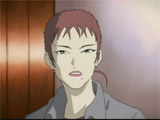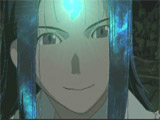

Quick Links:
Earth Girl Arjuna, Volume 4: Understanding
I should have seen it coming. The majority of "Arjuna" was standard mahou shoujo fare with earth-crunchy granola baked right in; but in volume 3, the anime really showed me what it could do. The characters were interesting and developing nicely, and that introspective tone was definitely the key to greatness. However, every time they edged in some plot, we were reminded just how silly, vague, and cliché the mechanics of the plot was. This concluding volume, consisting of a two-episode Big Evil mini-arc (the tradition in the magical girl genre), in which the major enemy's plans come into full force and the super heroine channels inner strength at the very end and saves the day. I wouldn't mind this much, especially since "Arjuna" is technically mahou shoujo, and thus such an ending is not only suitable but also somewhat expected of the show. The problem is that the villain makes no sense.
Throughout the series Juna has fought the Raaja, and in my previous reviews I've made comments on how sketchy the concept was. Sometimes they're symbolic of real-world pollution, sometimes they're invisible earth demons, and still sometimes they're visible. And then when Juna first started out, Chris warned her not to hurt them, yet just last volume we saw her on a S.E.E.D.-sanctioned mission to NYC with the specific mission of destroying the raging Raaja. I had hoped there was some Big Secret to be revealed at the end that would clear up all of these contradictions, but alas, they just heap more and more mythos onto it that become even foggier as time goes on. I realize that they are attempting to show a country finally being destroyed by its self-imposed pollution problems, but this whole scenario doesn't work with what we've seen so far (logically, not thematically).
And, unfortunately, I can't even use the great characterization as a counterweight to the silliness this time, as everyone shrugs off a personality and goes into survival mode. I get it, really I do: our society is so built around modern conveniences that without them people are nothing. That may be fine and dandy for the anime's "message," but it also reduces these characters we've seen evolving into deep and complex people to doomed and depressed blank faces. Even characters not in survival mode don't get justice done to them, because they are hardly used here at all. What was the point of telling us the S.E.E.D. agent's back story last volume if she's on screen for a total of five minutes this volume? One might argue that Juna and Tokio both get good character scenes here, but Juna just really gains more of that mystical crap she's been "learning" the whole series, and Tokio's developments are entirely out of character. The only true payoff was with Cindy, but even that ending was just taking the nicest route out of the story.
Though, I will mention that the whole commercial trick at the icon break was genius, even if they already used it a little before. It's cute moments like that that keep this series fairly decent even in the suckiest of times.
Having said all that, I will mention that the audio/visual side is great this volume. It seems they saved a lot of their non-CGI tricks for the finale, because the graphics here are just astounding. The sky battle with the Raaja over Tokyo was especially beautiful, as I was really sucked into the motion and action of it all. The final Big Enemy--if you can call him that--looked pretty cool, even if he made no sense at all story wise; and also there are some pretty cool details in the post-apocalyptic Japan. The music here is just as action packed, and I really enjoyed taking it all in. By the way, using the ole super heroine's-outfit-changes-with-changed-power cliché doesn't work if you just change the colors! I don't care if that's what Sailor Moon or the Power Rangers do, but even then do you really want to count those series amongst your influences?
Because of the low episode count, it seems Bandai has decided to pack the final volume with lots of extras. Good idea; iffy execution. The best ones are the extra commercials for the show-created fruit juice. I suspect there's an even bigger in-joke in that the little plush mascot was released with the original DVDs in Japan. However, not knowing much about Japanese merchandising, it's only speculation. We also have a music video by Maaya Sakamoto, who is one of my favorite Japanese artists, so that's another plus.
But all this is dimmed when we get to the cast interviews. Uggh. Now, first of all, interviews with American voice actors do very little for me, since while I can see they're just trying to build interest in the American anime fanbase, it really just exposes how low-grade the production values for the domestic release was. Also, the people here are a bit of a mess. The interviewer (I think he's the producer) is terribly unprofessional, and he seems more interested in speaking about his own bland impressions of the series instead of letting the actors talk (that's my job, not yours). Of course, this interview concept also depends on having actors who know anything at all about the show. The sessions were obviously done right after recording just the first two episodes, so they know nothing about the characters and can't really improvise well (Cindy's VA seemed especially clueless, which is fair given that the nothing is explained about her character at all in the first disk; wouldn't it seem a bit more rational to have her read the script for the whole series first so that she knew where Cindy was coming from?) And given the interviewer's unprofessional mannerisms, tacky wadrobe, and cinematography that screams junior high English class project, I'm gaining a whole new appreciation for those interviews on the Steel Angel Kurumi disks, which were at least tolerable.
The end of a series is probably the most important part. This is when everything we've seen so for has to reach a logical place where the viewer can leave the imaginary world feeling content and emotionally affected. That just doesn't happen here. Logic itself is disposed of, and characters are traded in for symbols of society. The story becomes a little to stereotypical of its genre for its own good, and really very little payoff is present. However, the series itself has been mostly above average, so if you don't mind a little Greenpeace in your Wedding Peach, go ahead and try it. It's very pretty.
Distributor: Bandai Entertainment Creator: Shoji Kawamori / Satelight Released: 2001
Video Quality: A+ Audio Quality: A Presentation: B+ Content: C+ Overall: B



